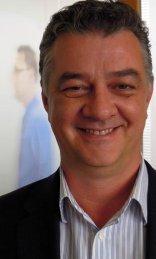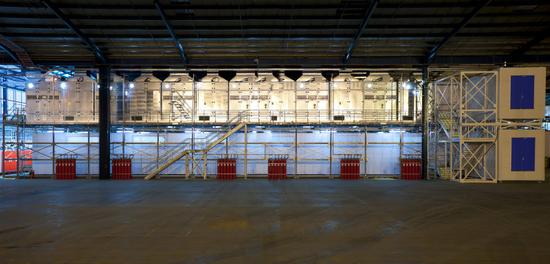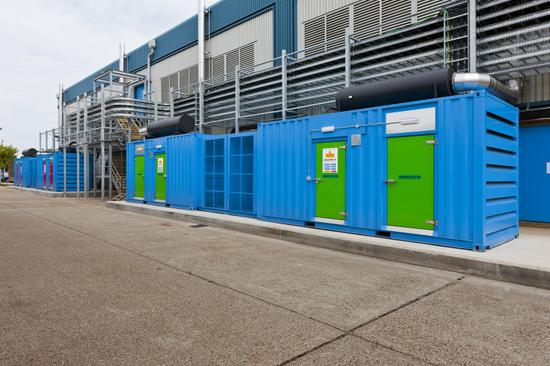Interview: Mark Leonard, Colt's Bridge Builder
Mark Leonard from Colt has helped bring the operator's networks and IT teams together and is now reaping the benefits
August 18, 2011

Of all the network operators in The Top 20 Bridge Builders, pan-European operator Colt Technology Services Group Ltd is the one that has actually Bridged the Chasm and restructured itself, its culture and its market proposition around the convergence of its network and IT assets.
Following a very swift transformation process in late 2010, Colt, which sells voice, data and managed services to enterprises and wholesale customers, emerged on January 1 with three "customer-facing units" -- Colt Enterprise Services for direct sales, Colt Communication Services for indirect sales and Colt Data Center Services for, well, selling data center space -- and two service units to support the customer-facing units.
Those two service units are the Business Services Unit, which offers numerous support services, and the Infrastructure Services Unit, which is where Colt has, in Light Reading parlance, Bridged the Chasm. (See Bridging the Chasm: A Manifesto and Bridging the Chasm Briefing Center.)
At the helm of the Infrastructure Services Unit is executive vice president Mark Leonard, who was previously Colt's CIO, and before that the CIO at Vodafone UK . We met Leonard in his office in the City of London, where he gave us the lowdown on what Colt, which operates a 21-country, 33,000-kilometer network, has done, why, and to what effect.
We met Leonard in his office in the City of London, where he gave us the lowdown on what Colt, which operates a 21-country, 33,000-kilometer network, has done, why, and to what effect.
Contents:
— Ray Le Maistre, International Managing Editor, Light Reading
Light Reading: Can you tell us about Colt's reorganization and your role in the 'new' Colt?
Mark Leonard: We redeveloped our strategy in about 2009 into what we call the Information delivery platform. Colt was in a unique position in Europe to offer integrated computing network services because of our fiber network on top of which we have 19 data centers. Coinciding with the prevalent market forces, which were forcing many of our customers to rethink their supply models in the compute, IT and network space, was the maturation of virtualization as the foundation technology for cloud. We found ourselves in a very unique position.
Whether you call it an information delivery platform, or integrated computer networking, it's a differentiator in the market today because it's the only way to provide a true end-to-end SLA [service level agreement] across the whole of the user's experience. And it's a market differentiator in the future because as more and more companies migrate their services to the cloud and cloud consumption-based models, they're going to start to demand elasticity in the network. If I am a website that sells tickets for major concerts, I want to flex for designated periods and flex access over a network as well. If I buy a hosted desktop, if I buy 2,000 [seats], what I actually want to buy is a performance-based SLA. And if I want to buy another 500, then I don't want to make any physical changes on the network.
It's going to mature in terms of complexity of demand from our customers, and that will include a complete evolution of the pricing and consumption models toward usage-based pricing like there is in the mobile industry.
Looking at all that, it became clear to us that our organization needed to change strategically to facilitate the delivery of [the new services], from a strategic, architectural, design, build, operate and service model.
Light Reading: So what changed? What was different before and after the transformation?
Mark Leonard: In 2010 we still had four disparate technology groups inside the company. We had: traditional network operations, which designed and built and maintained the network and the voice and data products for the company; a managed services division that did the same but for the compute side of the house; a technology group that focused on R&D and long-term stagey and product development; and an internal IT department, which focused on the consumption of all the disparate systems that a service provide/telecoms company/managed services company requires.
By the time we got to 2010 there was already a certain amount of blend between the internal IT services team and the managed services team. We had already seen a benefit and been able to partake of that benefit by eating our own dog food ... or drinking our own champagne, which is a more polite way to put it.
We launched the cloud data center service with VMware Inc. (NYSE: VMW) as the sole partner in Europe for Vmware. We had run that as beta internally, providing many of our internal IT services off that platform before we had even launched it [commercially] and got great benefit by being able to do that. (See Colt Offers vCloud.) Another example is the work we have done around the VDI [virtual desktop infrastructure] space. Again it is built from the product set, but we have used it internally, we can benchmarked it, we can stress test, and we can understand how may virtual desktops you can run on a blade and how much network you need to serve that across different distances and what works from a latency perspective, and you build up some real experience around that.
Another example is the work we have done around the VDI [virtual desktop infrastructure] space. Again it is built from the product set, but we have used it internally, we can benchmarked it, we can stress test, and we can understand how may virtual desktops you can run on a blade and how much network you need to serve that across different distances and what works from a latency perspective, and you build up some real experience around that.
So when we decided to restructure the company it was a logical decision to create the Infrastructure Services Unit ... actually we should have called it the integrated computer networking services unit, but that's too much of a mouthful I guess ... and we combined all those four organizations into a single one, all the technology in the company.
My role is that I am responsible for that whole piece.
Light Reading: When you announced you were going to do this, was there a sense of apprehension that this would result in changes that some people might not be able to comprehend, in terms of what it might mean for the company or for themselves?
Mark Leonard: It was easier for people to see where it was taking the company. But definitely some people wondered what it would mean for themselves. But one of the most important aspects of what we do is around people, and I have said before that technology is 98 percent about people and 2 percent about technology. If it was just about the technology it would be easy. So we set out on this course with a very definite focus on what it would mean from a people perspective and a cultural perspective.
So we announced this in September 2010 and started on the process of building the new organization, but as soon as we started we talked to the people that would be inside the new organization, which was launched on January 1, and made it clear the benefits for them. We ran the program in two stages: transition; and the stage we are still in ... the transformation. But during the transition we made it clear that one of the four things we would be focusing on would be our people -- developing our people. If you think about the benefits a single [division] delivers to a company like Colt, you can offer clear career paths that people can pursue, which we couldn't do before in a much more fractured environment ... you can create opportunities and allow people who want to be managers and leaders to progress and perhaps most importantly of all you don't force good technical people to become managers.
On my top table I have the chief IT architect and the chief network architect and everyone in the company can see that, if they are technical, that is an aspiration they can have, to be at the most senior levels within Colt. They can join our company at the helpdesk in Gurgaon in India, which is the internal IT helpdesk, and see a career path that stretches out and see the skills you would need along the way. I think that's very powerful and a very positive message to send to our people.
Light Reading: Were there any other changes related to people and skills?
Mark Leonard: We looked at some of the other messaging. We very deliberately moved to an ITIL [Information Technology Infrastructure Library] model. We chose ITIL because we believe that more and more the service-based decision or acquisition that our customers will make will be driven by more of an IT mindset than a telecom mindset. There were some people that said, 'Why ITIL instead of eTom [Enhanced Telecom Operations Map]?' Well, ITIL translates to our customers. That's the way our customers look at the services and that's how they understand services. We wanted to speak the same language, and we wanted them to be able to understand the processes within our organization in a very transparent way. When we designed the organization that was one of the key founding principles -– to be an ITIL-based, process-based organization.
So we lost the identity of all those four old organizations and have created a process-based organization. All the services we consume ourselves internally are consumed on exactly the same basis as our customers. It's a great way of doing things. You get to understand the customer experience, very quickly.
And then we have the classic support functions -- finance, HR and so on -- and we also created a team called transformation and governance to focus on continued transformation. We have put all our project and program managers in that team because we want them to be multi-disciplinary in terms of our solutions, services and product base, but also by putting a large number of managers together we can assess, train, improve, promote ... and you can create the professionalism. In terms of our external customers they have to be the best of the best and compete with other companies that have very good people. So we moved to that on Day 1. Light Reading: What are the key advantages of the new operation and the pitfalls? Everyone expects the main advantages to be the ability to respond more quickly and with more understanding to customer requirements.
Light Reading: What are the key advantages of the new operation and the pitfalls? Everyone expects the main advantages to be the ability to respond more quickly and with more understanding to customer requirements.
Mark Leonard: I think the silos have literally disappeared overnight. People talk to each other. People have the sense of being in one team together. It has created an openness and transparency that has enabled us to see very quickly where the gaps used to exist in the old world. But we are retaining pools of network competence –- I want the network engineer to be the nest network engineer, I don't want them to be half a network engineer and half a VMware specialist. I want them to be the best of the best. But they do need to be able to talk to each other and be able to work together. That's what we have seen. That has been the biggest benefit. It has facilitated the communication.
From an operational perspective, you may have gone to three different areas for help if you have an outage but now you are going to one team. One of the first things we combined was our NOC [network operations center]. We wanted to send a very strong and simple message. Let's get all the guys in there and monitor our customers on a real end-to-end basis. And that's at the heart of things and people understand that. And where possible we have blended the teams together very quickly to bring products and services back to the organization more quickly.
One of the key processes we rewrote very quickly -- we launched a new Time to Market process at the end of the first quarter. We worked very hard to see how we could take our lead times down and leverage the new organization and look at some different ways of working.
And we have been empowering the people, too. Fixed line telecoms had the luxury of starting out in a world that was highly engineered. The cycle times between technology change was much longer. Now the world has changed, but I think we still have a bit of a legacy mentality. If you were going to change something you would look for everyone, or someone very senior, to sign it off. But we have said, if you are the architect or analyst or subject matter expert, and feeding the requirements in, then you get to make the decisions because we need to move more quickly.
Light Reading: What about things you have had to firefight?
Mark Leonard: My senior team has had to use a lot of shoe leather and talk to people face to face both before and after [the transition]. And I am still concerned about communication and having the right culture around communication. We are at a crossroads with the workforce from what has been a push culture to what hopefully will be more of a pull culture ... I think we still have some people who are used to, well, 'the company must tell me, the company must inform me.' It is critical that people understand who they are and how they fit into the company's goals and day-to-day activities, and if you [the management] can't articulate that then that's a real challenge. And that has to be embraced by all the management [levels] because there aren't enough senior people to go around.
Light Reading: What has the customers' reaction been to the changes?
Mark Leonard: I think very posituive. I think we have been able to short-circuit and get to the bottom of some very difficult issues, and the customers have noticed that. And when you go and see a customer who has bought a solution and it involves some virtualization, some load balancers, managed firewalls and an IP VPN, and they sit down with a guy who is really responsible for all of it, that is really powerful. I have sat in meetings as a buyer of IT services in front of a person who says he is responsible for all of it, but you know he isn't really. So that has been very persuasive. Also our ability to provide that end to end service is starting to become a differentiator.
Light Reading: Have you noticed that, by bringing people with different skills together, whether that has created any new business or service ideas, or is it too early for that?
Mark Leonard: I think what has happened is that people who thought they were strangers –- people from Planet IT and Planet Network –- have realized actually that they are from the same family. What we are seeing is new ideas ... but more importantly [the identification of] the gaps in the services we have today. If they work together [they will see] how easy it is to fix them. It's also interesting that the religious fanaticism that people have -- does a service belong in a data center, or in [muffled] -- that is going away. There are a lot of light bulbs going on. The one salient moment for me was that I had two relatively senior people and both had been in the company for more than eight years, and they had never met. They are good people who are now learning to work together. We have much further to go with the cultural transformation.
It's also interesting that the religious fanaticism that people have -- does a service belong in a data center, or in [muffled] -- that is going away. There are a lot of light bulbs going on. The one salient moment for me was that I had two relatively senior people and both had been in the company for more than eight years, and they had never met. They are good people who are now learning to work together. We have much further to go with the cultural transformation.
Light Reading: What Colt has done –- is that equally as applicable to a more retail telco such as a Telefónica SA (NYSE: TEF) or a BT Group plc (NYSE: BT; London: BTA). Do you think they can apply the same ethos and derive the same benefits?
They have to, or they will lose market advantage. Definitely. The days of differentiating between your experience of a phone and the network have gone ... that is what Apple has brought to the market, it's an end-to-end service and not just about a nice new shiny device. We all need to embrace that or become extinct.
It's all been accelerated by the cloud. You need to be on the cloud train already or it will pass you by, and if it passes you by you will find it hard to monetize the pipes.
You May Also Like


_International_Software_Products.jpeg?width=300&auto=webp&quality=80&disable=upscale)







